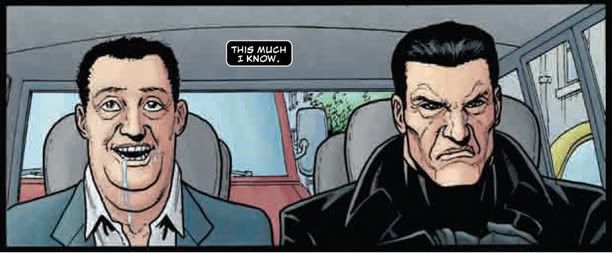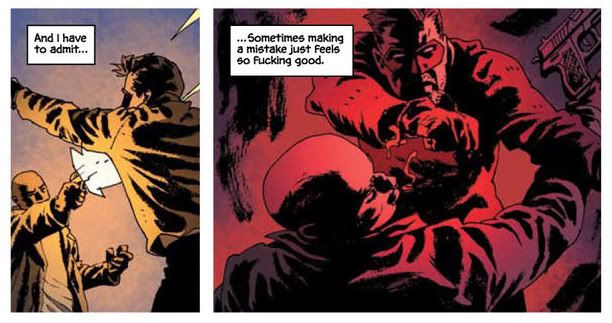A Flock of Reviews: Jog struggles to keep the short stuff short in re 1/2
/![]() Final Crisis: Secret Files:
Final Crisis: Secret Files:

Ha ha, well, turns out the real secret here has been 'what the hell is in this thing?' And anyone trusting in DC's original solicitation for "Art by Frank Quitely and various" are gonna be pretty steamed when they notice it's all various, no Quitely on the inside. Nor is alleged co-writer Peter Tomasi anywhere to be found, although there is some interior content by Greg Rucka & Steve Lieber, who are not credited on the cover. The best I can say is that it all somehow seems too bona fide haphazard to qualify as a bait 'n switch - I really do wonder what the original idea for this thing was.
Anyhow, the vast majority of what your $3.99 will get you is a 24-page Origin of Libra comic, in which character co-creator Len Wein effectively remakes his original 1974 Justice League of America Libra story -- which I do believe was just reprinted this past July in DC Universe Special - Justice League of America #1 -- with artist Tony Shasteen in place of the late Dick Dillin. There's also some added background details, and a crossover-appropriate through line to bring us right up to the present, which sort of suggests that the character's mysterious nature won't be playing much of a role in Final Crisis proper at all.
That's a shame, although it doesn't reflect too much on Wein's script, which I thought was actually charming at times in its old-fashioned 'supervillain has a story for YOU' style; I liked Darkseid's grandiloquence ("Or are you so foolish as to tell me that, for even an instant, you would dare to forget DARKSEID!") and I loved that last page. Shasteen's visuals do a decent enough job of squaring away the '70s origins of the stuff with the glossy realist Final Crisis style set down by J.G. Jones. But the irony of this expanded Libra's motivation -- a man seeking the power of the cosmos to escape his ugly family situation, only to fall happily into the thrall of the ultimate Anti-Dad -- don't have much of the resonance of conclusion, since this is a crossover tie-in and we can't really end the arc here. I do understand now what Grant Morrison saw in the character, though, even while I suspect I might have gotten the same effect from reading that reprint half a year ago.
The rest of the comic is filler of various types: Morrison himself presents a one-page mini-essay on the Anti-Life Equation that falls somewhere in between a recap of past storylines and an answer he might have been saving for an interview at some point in the future; Rucka & Liber have an excerpt from the Words of Lilith, which I presume ties in with Final Crisis: Revelations, and is otherwise too oblique to have much value; and then, since there's four pages left, we get stuff that was apparently left out of the Final Crisis Sketchbook, in much the same captioned designs format (this is the basis of J.G. Jones' cover credit, by the way), honing in on the Final Crisis: Superman Beyond supporting cast, various Anti-Life figures, and, er... Aquaman. Because... he's there?
Hmmm, maybe that says something about the comic as a whole. Deep, deep EH, although your feelings will probably be lower if you're already up on Libra.
Punisher: War Zone #4 (of 6):

Now here's some happier dissonance: a movie tie-in that has absolutely nothing to do with the movie it's tying in with, save for the presence of the title character. And I'm pretty fine with that! More than anything, this weekly series has behaved as an amusingly early opportunity for writer Garth Ennis to return to his signature corporate-owned comics character and show 'em all how a toss-off storyline gets goddamned done, even though I secretly know that Santa isn't real and the script has been sitting around completed for over three years, by Ennis' own admission (as to the script, not Santa).
It's been a good time, but what's striking is how much Ennis' pacing is aided by the miniseries' weekly schedule; what occasionally seemed a little too deliberate in monthly form (I can't be the only one who stockpiled issues of the MAX series before reading them) comes off as nicely needling when you know it's only a few days until the next part. Granted, that's all academic if you're just planning on reading this in trade form -- which is probably what Ennis is really pacing for, and arguably what more people will opt to buy since these weekly suckers are $3.99 a pop -- but it's nice to have a smoother experience for those who can't wait or like pamphlets and/or hate money or something.
And what's even more nice is that Ennis is skilled enough a writer to maintain a high level of accessibility for a plot that's essentially a chain of callbacks to the writer's 2000-04 Marvel Knights version of the character, in particular the character-reviving Welcome Back Frank storyline; frequent cohort Steve Dillon again provides the art. This particular issue sees Frank and witless mob underling Schitti (yep) still on the tail of the alive and seemingly omnipresent family boss Ma Gnucci, despite having already killed her multiple times this miniseries alone; little does Our Man know that a deeply odd supervillain team-up is happening behind the scenes!
Now, admittedly that's nothing you didn't know last issue - the plot is in 'inching forward' mode right now, and while Ennis has drawn the best comedy of the series out of steely police lieutenant Molly Von Richtofen and her increasingly horrible obsession with her roommate/lover, the level of zany antics in this particular issue (including a two-page fantasy sequence!) smacks a bit of padding. But few can bide time quite like Ennis, and Dillon always seems to tease out something a little better onto the page. OKAY as an issue, but you can bank on the whole being better.
Incognito #1 (of 5):

I don't know if Criminal has set my expectations too high by this point or if there's just so damn many superhero comics around that it's harder to be striking, but I wasn't very piqued by this new Ed Brubaker/Sean Phillips creation from Icon, despite my bottomless love for the term 'science-villain' and a general fondness for rough, pulp magazine-informed costumed adventure folk. This is a sort of supervillain noir piece set in a dim urban setting, with one-half of the infamous Overkill Brothers, our narrator, planted uneasily into witness protection.
But on a more immediate (if superficial) level, it's remarkably similar to Mark Millar's & J.G. Jones' Wanted, featuring an angry man with awesomely violent potential skulking around a boring work life, filled with loathing for everyone who pisses him off and half the people who don't, suddenly gaining the means to taste the power and freedom of amorality. There's a dead super-relative in his past, a mad science mentor and a shady organization that's wormed its way behind the operations of society, keeping the human sheep in the dark.
It's close enough that I wonder if this introduction isn't intended as a deliberate takeoff; certainly Brubaker is less fussy about the concept than Millar, letting us and his narrating character in on his wicked past right at the top. The dead relative is a twin brother and the mentor is also the 'father,' carrying through Brubaker's usual theme of family. Heaven knows Phillips and colorist Val Staples are far away from the slick glamor of Jones and Paul Mounts. And interestingly, the shady controller types are the heroes -- Jess Nevins presents a short backmatter essay on The Shadow, who wasn't exactly a paragon of active democracy -- while Brubaker cleverly has his villain blow off his newly re-powered steam by becoming a superhero, in the classic leaping down and socking muggers manner.
The thing is, all I'm seeing right now is potential, coursing through some fairly bland sequences of misanthropy and worldbuilding. Brubaker tends to a character-focused writer anyway, so maybe he just needs to get some added science-people into the picture to get the thing crackling, but for now it's mostly Phillips & Staples heating up the violence (outer and inner) with color and grit to keep attention. And even then, they're working in tight panels that mainly serve to muffle the science-action impact and draw attention to the former Overkill's psychological strife, which just isn't terribly interesting in its longing for freedom of the fists and skies.
OKAY in terms of possibility and technical chops, but it hasn't gotten me itching for the next issue like the better of this team's work.











